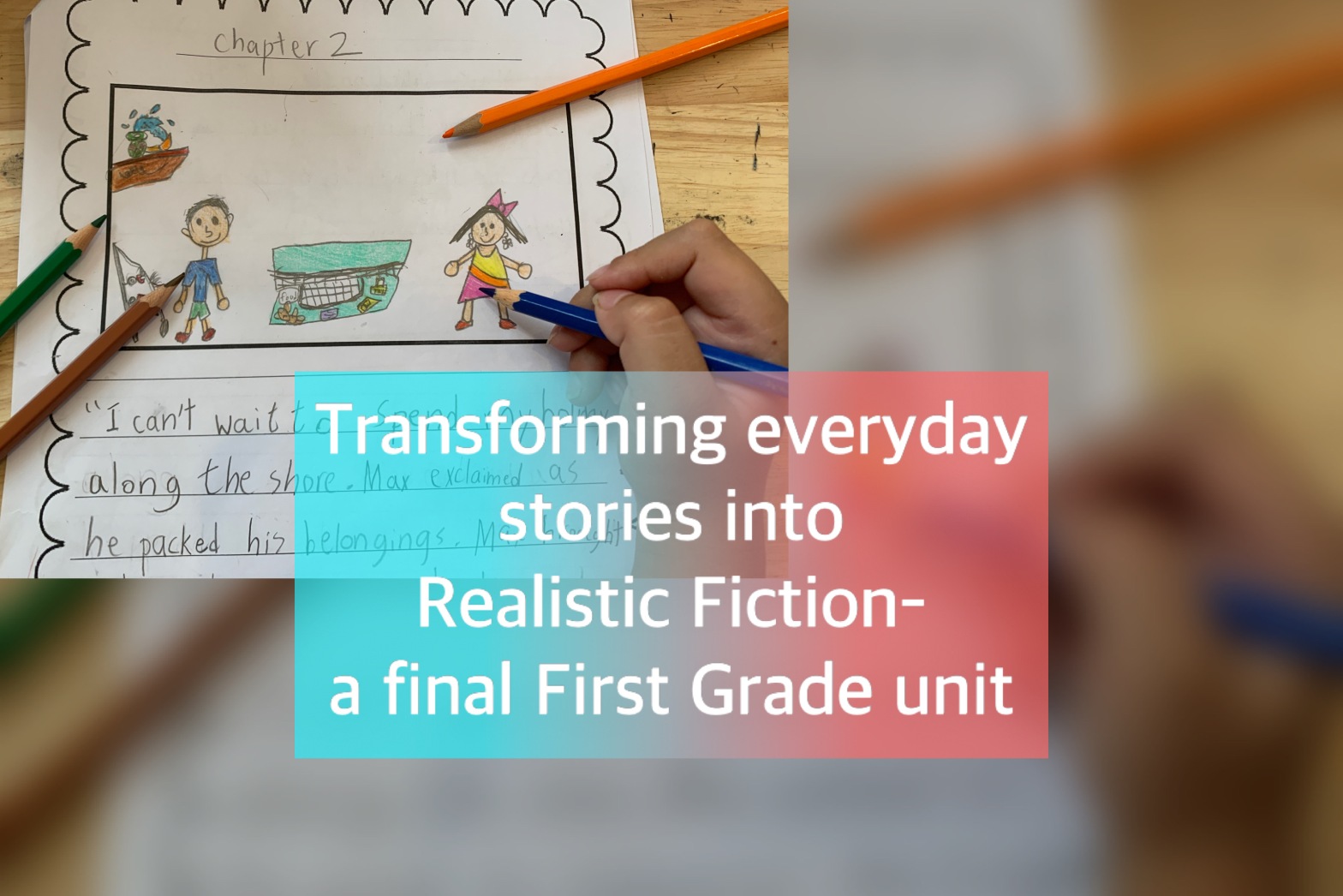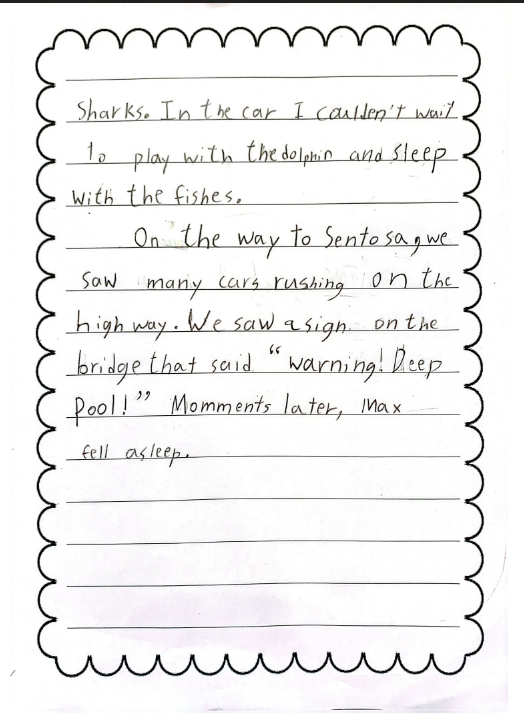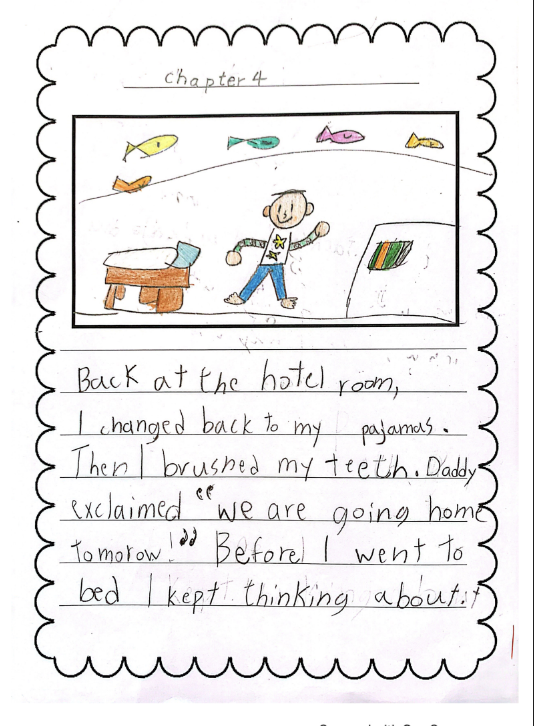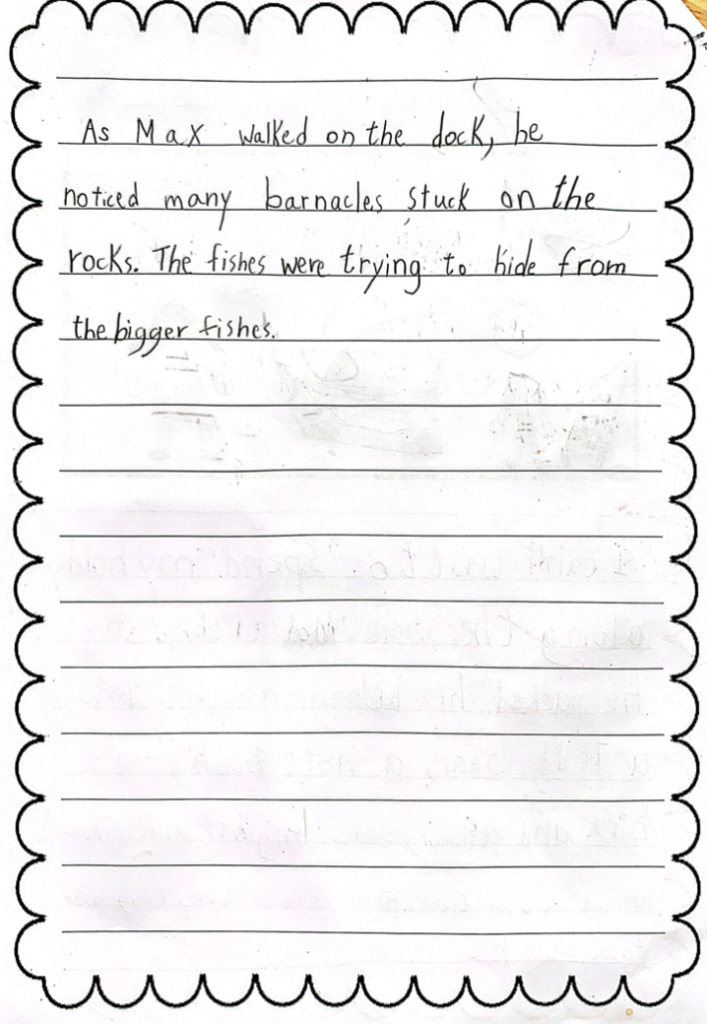- What is realistic fiction
- Getting started
- Planning the story with transferrable post-it notes
- Ways to Expand a story
- Drafting and Publishing the story
- Ways to Expand a story
- “Touch and Read’
- Grammar Integration
- Conclusion:
Realistic Fiction is strategically organised as the final reading and writing unit in First Grade. This is a sensible decision since writing realistic fiction encompasses a wide range of skills that are introduced and developed at the beginning of the school year. The timing of the Realistic Fiction unit allows First Grade students to showcase their growth and confidently apply the skills they have cultivated throughout the academic year.
Kai began the realistic fiction unit with a strong storytelling foundation. He could generate ideas independently and construct a story structure with a clear beginning, middle, and end. For children who may not be ready, please refer to a general story writing unit HERE.

What is realistic fiction
Realistic fiction is a type of narrative writing that presents stories set in a world that closely resembles that of our own.
Here are some key features of realistic fiction:
- Takes place in settings that are familiar and believable (home, school, park)
- Explores events and scenarios that could happen in the real world
- Has characters that are relatable and often face everyday challenges and struggles
Getting started
Similar to the approach taken in other writing units, I launched this unit by reading realistic fiction series, which I have written extensively about here (HERE) In short, we analyse different stories using this PROBLEM ATTEMPT SOLUTION template which helps Kai understand the framework of realistic fiction before he begins planning his own story. Download the template here
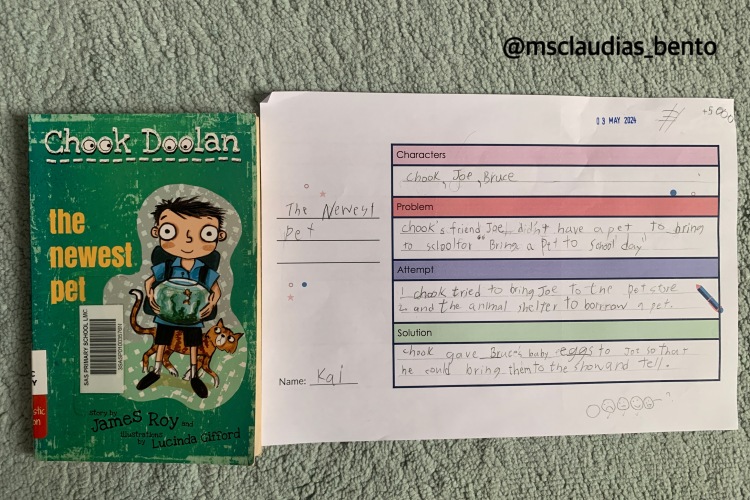
Planning the story with transferrable post-it notes
After reading realistic fiction stories and studying their examples, Kai begins to plan using the same template, making sure there is a clear problem and solution.



Then, comes our favorite part! Kai sketches a rough outline of his story, and sticks the Post-it notes on this A3 tri-fold paper, ensuring that the BEGINNING, MIDDLE and END are clearly identified. Before he does any writing, he proceeds to do his “Touch and Tell” which you can learn more about here (HERE)
Ways to Expand a story
Children often encounter difficulties when attempting to expand a summary into a full-fledged story. Expanding a summary requires children to think creatively, visualize scenes, and develop characters and plotlines. This process can be challenging for some children who are still developing their storytelling abilities. Children may also find it hard to think beyond the basic details and delve deeper into the story.
I follow TCRWP’s strategies to help Kai expand his ideas into stories. I am currently working on tutorial videos which parents can purchase to develop these storytelling skills. Do stay tuned.

Drafting and Publishing the story
This next step is important as it instills in children the practice of following their own story plans when drafting. While ideas can change, taking the time to establish a rough plan serves as a valuable step in writing.

I ask Kai to remove the sticky notes and transfer them individually onto lined paper. He starts with the BEGINNING section, and writes out his draft, paying attention to incorporating dialogues and step-by-step descriptions of his character’s actions and thoughts. During this stage of writing, I introduce a variety of transitional phrases to Kai, which he incorporates appropriately when writing. I highly recommend Emma’s book “A Way with Words: Word banks and descriptions to bring your creative writing to life” (HERE) as we find her choice of transitional words very helpful!

Ways to Expand a story
I know there are many parents who struggle because their child has a hard time expanding a story from the planning stoage.
“Touch and Read’
After completing his entire story, which takes a few days’ time, Kai does his #touchandread looking specifically for any errors related to capitalisation, spelling or verb tenses. As Kai reads, he physically touches the words with their finger or a pencil. While reading and touching each word, he actively looks for errors such as misspellings, grammar mistakes, punctuation errors, or unclear sentences.
Grammar Integration
As a means to incorporate grammar study, I introduced adverbs, quotation marks and reinforced the usage of correct past tense verbs in this unit.
Adverbs
I created “Grammar Folders” for the units, which look like this. We go over the difference between adverb of place, manner and frequency, and Kai sorts examples of them inside the folder.
I also posted a simple reminder poster on the wall.

I downloaded more examples of adverbs from Twinkl (HERE) and wrote sentences using the vocabulary as such.
I also came up with my own activities with adverbs that are a little more challenging.

Past Tense
To make the learning of irregular past tense more engaging, I created an interactive activity using two dice. One die contains adverbial phrases, while the other contains verbs. Kai is asked to roll the dice and craft sentences that incorporate both sets of words. This is an easy way to make sure he practices tense change.
Quotation Marks
One of the big milestones many children reach when writing their realistic fiction is the inclusion of characters dialogue as a way to enhance their stories. However, incorporating dialogues can be challenging for First Graders, and I have developed a strategy to help them using highlighters.
Conclusion:
The Realistic Fiction Unit offers children a valuable opportunity to create stories inspired by their own experiences, fictional characters from books, and the mini adventures they dream of having. It is a meaningful unit that combines the skills of writing a narrative, exploring imagination, and fostering creativity. Through this unit, children cultivate their storytelling abilities and deepen their comprehension of plot structure, emphasizing the importance of a clear problem and solution element. This unit empowers Grade 1 children to become confident writers and storytellers, cultivating a lifelong love for literature and the power of their own words.
Here are the 3-part HEY MAX series (inspired by Hey Jack) :
Hey Max 1: The Aquarium Adventure
Hey Max 2: My Underwater Birthday
Hey Max 3- FIshing Fun
See all related blogposts:
What “Small-Moment Writing” looks like in First Grade (at home)
Lucy Calkins’ units are not perfect, but her “whole language” approach does nurture a love of writing. She places a strong emphasis on writer’s craft, and it is not at all too early for 6-7 year olds to start thinking about how authors make a purposeful choice of vocabulary, sentence formation, voice OR tone in…
From Goals to Words: Using Soccer to Inspire Your Child’s Writing- A non-fiction research unit with my 7 year old
What is Non-fiction writing? Non-fiction writing is a type of writing that aims to inform, explain or educate others about people, events, or issues. Non-fiction writing is: It is important to do a balance of fiction and non-fiction writing. In international schools, students do a combination of fiction and non-fiction study throughout the year. In…
Supporting your child to write stories with a clear Beginning, Middle and End- foldable trilingual template
Every story should have a beginning, middle and end (BME). One of the many literacy skills a child needs to learn early on is is BOTH to identify BME of any stories, and to write a story with a clear BME. The Picture Book Teacher (here) has a great blog post on the importance of…
MUST-HAVE literacy resources to support your child at home (Ages 1-7)
(I will continue to update the blog. This article was first published in 2022 and was last updated in April 2022.) Since then, I have also introduced my own Science of Reading course, designed to provide you with a comprehensive understanding of how children learn to read. This course aims to empower you by enabling…
Ms. Claudia’s favorite early chapter book series
Introduction I have specific preferences when it comes to early chapter books, and my criteria for identifying good ones is based on the accessibility of language for children who are transitioning from decodable books and bridging books to chapter books, as well as a story structure that is straightforward, with a logical progression of events.…
